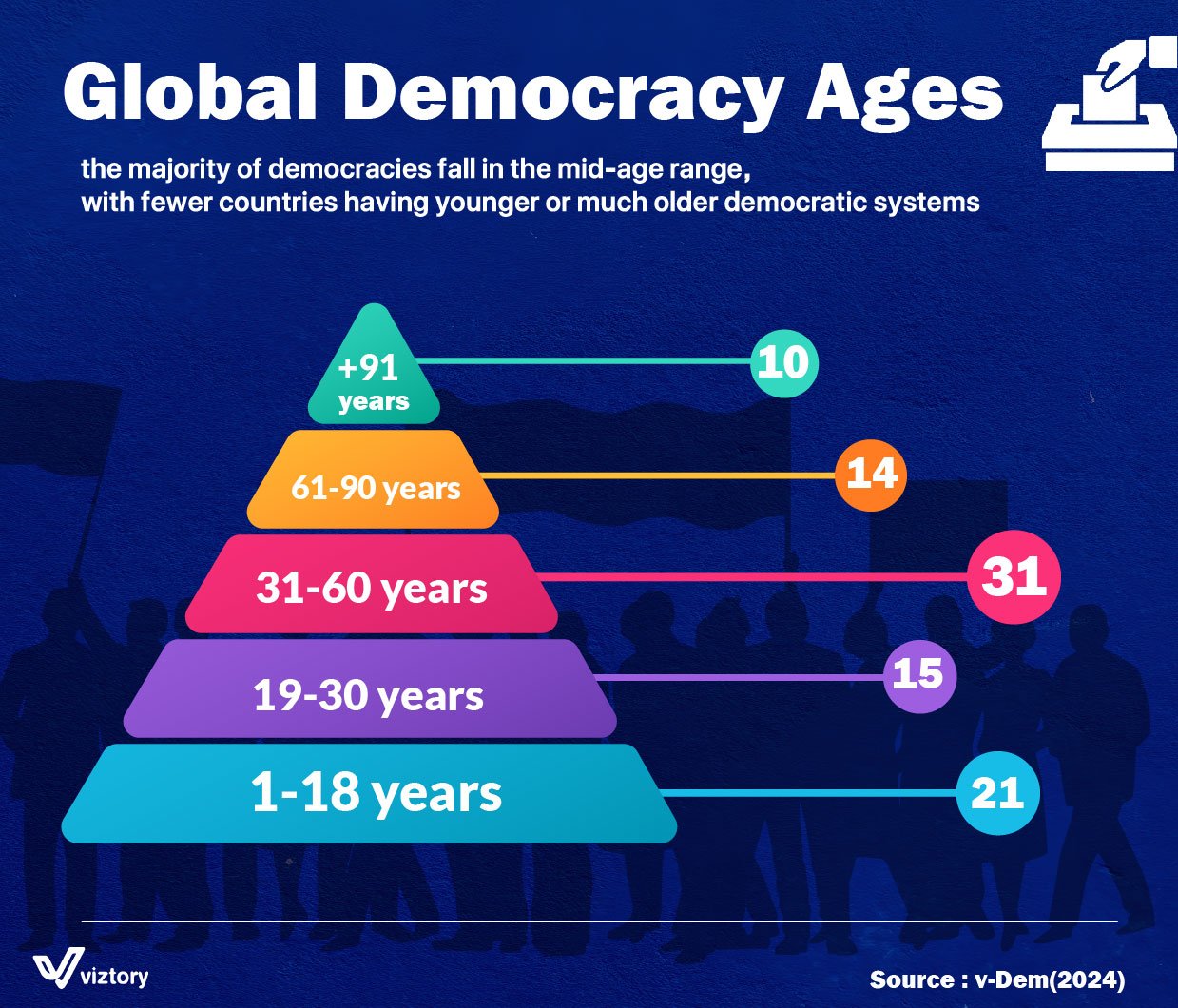Global Democracy Ages
-
Oct, Fri, 2024
Global Democracy Ages: The Link Between Democracy and Economic Growth
The visualization of global democracies highlights the varying ages of democratic systems, with the majority falling within the mid-age range of 31-60 years. Democracies that are younger or older than this group are fewer, creating an interesting spectrum of political maturity. This variation in the “age” of democracies plays a crucial role in shaping the economic trajectories of nations. A stable and long-established democracy often correlates with strong economic institutions, while newer democracies may still be finding their footing in governance, affecting their economic outcomes. This article delves into the connection between democracy and economic growth, exploring how the age of a democracy can influence its economic landscape.
How Democracy Fosters Economic Growth
Democracy is often associated with economic growth because it tends to promote stability, accountability, and transparency, which are critical for a healthy economic environment. Countries with long-standing democracies, like those in the +91 years category (10 countries), have generally developed stronger institutions, consistent legal frameworks, and sound economic policies over time. These elements are crucial for creating an environment conducive to business, innovation, and investment.
In democracies, free markets and property rights are typically respected, encouraging entrepreneurship and foreign investment. The checks and balances within democratic systems ensure that economic decisions are subject to oversight, reducing the risk of corruption and inefficiency. Long-established democracies, such as those in Western Europe and North America, exemplify how mature political systems can foster sustainable economic development.
Older Democracies and Economic Stability
Countries with democratic systems older than 91 years tend to enjoy relatively stable political environments, which translates to economic stability. These countries have experienced the evolution of democratic norms, such as the rule of law and robust institutions, leading to a predictable economic environment. Investors are more likely to engage with economies that have a long history of political stability, knowing that their investments are protected by legal frameworks and property rights.
Additionally, older democracies often prioritize social welfare programs, public health, and education, which contribute to higher levels of human capital. This, in turn, fuels economic productivity. For example, Scandinavian countries, which have long-standing democratic systems, consistently rank high in global human development indexes and have thriving economies that balance market freedom with social equity.
The Mid-Aged Democracies: Economic Opportunities and Challenges
The largest group in the visualization falls within the 31-60 years range (31 countries), representing mid-aged democracies. These democracies are still in the process of consolidating their democratic norms while simultaneously managing economic development. For many of these countries, particularly in Latin America, Eastern Europe, and parts of Asia, the transition from authoritarian regimes to democracy has opened up opportunities for economic growth, as democratic reforms have often gone hand in hand with market liberalization.
However, many mid-aged democracies also face significant economic challenges. While political reforms have been implemented, economic institutions in these nations may not yet be fully developed. For instance, issues like corruption, weak rule of law, and economic inequality can still be prevalent, which can hinder economic progress. Countries in this group may experience economic volatility as they continue to navigate the complexities of democratization while striving for economic growth.
Younger Democracies: Growth Potential Amidst Political Instability
Younger democracies, particularly those in the 1-18 and 19-30-year ranges (21 and 15 countries, respectively), often face the dual challenge of political instability and economic underdevelopment. Many of these countries have emerged from periods of dictatorship, colonialism, or conflict, and are working to establish democratic norms while trying to grow their economies.
In these nations, economic growth can be stifled by political instability, weak governance, and nascent institutions. Without a well-established legal and regulatory framework, economic decision-making can be erratic, deterring investment and leading to economic inefficiencies. Nonetheless, younger democracies also hold significant growth potential. As they strengthen their democratic institutions, they can unlock economic opportunities by attracting investment, enhancing productivity, and fostering innovation.
Democracy’s Role in Reducing Economic Inequality
Democracies, particularly mature ones, tend to have mechanisms in place that address economic inequality. The ability of citizens to participate in political processes through voting and civil discourse leads to policies that aim to improve social welfare and reduce economic disparity. Established democracies with strong social safety nets, such as those in Western Europe, often prioritize public spending on health, education, and welfare, which helps to reduce inequality and boost long-term economic growth.
On the other hand, in newer democracies, the fight against inequality can be more challenging. Weak institutions and limited political accountability may mean that economic growth disproportionately benefits the elite, leading to greater inequality. Countries in the earlier stages of democratization need to focus on building strong, inclusive institutions to ensure that the benefits of economic growth are widely shared.
Economic Growth and the Global Democracy Pyramid
The pyramid structure in the visualization is symbolic of the gradual accumulation of political and economic maturity. Just as democracies grow stronger over time, so too do their economies. Countries in the top tier of the pyramid (+91 years) have reaped the economic benefits of stable governance over decades, while countries in the lower tiers are still working towards achieving the same level of economic and political maturity.
As younger democracies continue to grow, they have the opportunity to implement lessons from more mature systems, balancing democratic principles with sound economic policies. This will be crucial for their long-term success, both politically and economically.
Conclusion
The age of a democracy plays a crucial role in shaping its economic performance. Older democracies tend to have stable economies with strong institutions, while younger democracies face challenges but hold potential for growth as they strengthen their political and economic systems. As global democracies continue to evolve, the relationship between democratic governance and economic prosperity will remain a key factor in determining the future of both individual nations and the global economy.

